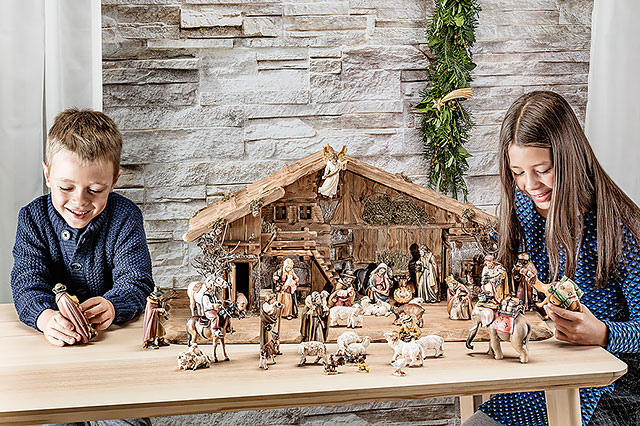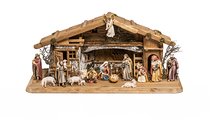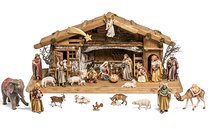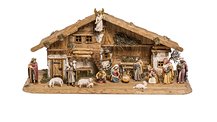Paper figures
The paper nativity scene figurines can be made of white drawing paper, colored construction paper or a little more solid photographic cardboard. Here, conical figures with a high degree of stability have prevailed. There are ready to copy instructions showing subjects to paint, cut out and assemble. Particularly practical are the pre-cut sheets of paper that do not require scissors. The paper is suitable for making figurines with children as the material is cheap and children have a lot of freedom to put their creativity into action. A valid alternative is papier-mâché; a malleable pulp made of paper mixed with water and glue. It is coloured as soon as the nativity scene figurine is completely dry. Marolin is a special papier-mâché that is used by a manufacturer based in Thuringia for the realization with papier-mâché: below is a short film that shows the creation process.
Plastic figures
The plastic crib figurines are characterized by their strength and durability. They are created in the casting process with the help of reusable moulds and harden under pressure in a temperature range from 250 to 300°C. They are inexpensive and suitable for children to play with. With latex moulds, plastic figurines can be easily made by themselves. Stewalin or Keramin are recommended as casting compounds. There are also figurines made of synthetic resin, cast resin, bakelite, polyresin or kevlar. All materials can be summarized under the generic term plastic.
Ceramic figures
 Figures of the Nativity of Hutschenreuther
Figures of the Nativity of HutschenreutherThe term ceramics refers to crib figurines of various materials such as clay, porcelain, terracotta and clay. The clay figurines are shaped by hand, then dried, decorated and glazed, and finally fired in a special kiln at more than 1000 ° C. Terracotta is a material of the ceramics group. The terracotta works remain unglazed and are characterized by the typical reddish-brown color even after firing. The difference between clay and clay lies in the degree of contamination of the material. While clay is made of pure clay minerals, clay contains more deposits / impurities of organic origin, for this reason, clay is more suitable as a building material for masonry or bricks and is rarely found in handicrafts. From time to time, however, you can see the nativity stables, where clay was used to build the side walls. The porcelain nativity scene figurines are offered in the assortment of well-known manufacturers. In general, ceramic works are very hard and waterproof. The disadvantage is that they are easy to break and are not shockproof..
Chalk figures
The nativity scene figurines are made of mixed plaster with the addition of special synthetic resins. The plaster powder mixed with water is poured into specially made moulds and dried in them. In the past the shapes were made of a plaster coating, today they are mostly made of silicone. To increase the durability of the resistant fabric particles, wet plaster threads have been added in many cases, which has become unusual today. Once the plaster has hardened, the nativity scene statue can be removed from the mold. The surface is smooth and only needs to be worked on in exceptional cases in individual places (e.g. small holes that have been created by air bubbles). For larger works, consisting of several pieces of plaster, wire reinforcement is used. The transitions between the different parts of the plaster (so-called casting seams) are removed using knives, which requires a lot of experience and skill. When the rough is ready, the surface is sealed and hardened using bone glue. At this point you can apply the primer and start painting. Oil-based paints are used for painting, applied in the past with a brush and today with a spray gun.
Chalk statues are generally very sensitive. They are fragile and break easily. It may therefore be useful to cover the crib with moss or fabric to avoid damage to the plaster figures. Older statues are therefore often damaged and some specialist knowledge is needed to restore them. However, experts can restore a damaged plaster figurine in excellent condition while maintaining the original character (expression, material, color) throughout. For restoration, we recommend Esper vom Krippenkabinett: krippenkabinett.de
Metal figures
 Pewter nativity scene figures
Pewter nativity scene figuresThe metal figurines can be made of copper, tin or brass. On www.zinnfiguren.de there are beautiful figurines of the crib in tin alloy, in bronze as miniatures or standing figurines. Gold is mainly found in the form of gilding or decorations. But there are gold decorations for Christmas trees with nativity scenes. Silver nativity scenes are often combined with glass and, for example, placed in a glass ball of the Christmas tree. Sometimes you can see silver cribs on Christmas candle holders. A particularly valuable nativity scene made of silver and mother-of-pearl is on display in the nativity scene at Karlstein Castle in the Czech Republic.
Wax figures
Beekeepers love to use beeswax from their hives to make candles and Christmas tree decorations. In addition to angels and stars, there are also wax nativity scenes. Beeswax pendants are often provided with a gold-colored ribbon so that they can be hung on the Christmas tree. The Catholic Church of St. Ludgeri in Münster, Westphalia, has a precious nativity scene made of old wax figurines made by the nuns in Aachen in 1868.
Paste figures
The dough to create the statuettes of the salt dough nativity scene consists of flour, salt, water, food coloring, wooden sticks and tools. The subjects of the finished dough are baked in the oven for two or three hours at 100-120 ° C. After cooling, the transparent varnish is fixed by spraying. In Upper Franconia, Saxony and Thuringia it was customary until the middle of the 19th century to make crib figures from a mass of black flour, salt and water. Gingerbread nativity scenes are very special in this context, particularly appreciated by children, who built little houses during the Advent period to complete them with gingerbread figurines. During the Christmas period, an exhibition of gingerbread nativity scenes made by bakers in Pardubice, Eastern Bohemia, takes place in the Nativity Museum of the Czech Castle Karlstein.
Fabric figures
 Wool nativity scene figurines
Wool nativity scene figurinesThe fabric Nativity figurines can be made of cotton, wool, felt, jute, silk, rope, velvet, flannel, batiste, pannolenci and many other types of fabric. Often scraps of fabric are combined with each other. You can find fantastic works made of felt and wool with a very personalized design on www.filzfiguren.com.The fabric figurines can be flat or padded. The single cut parts are sewn together or, as with felt, glued together. A variation are the finger puppets that are empty from below. The fabric figurines are ideal for children, to whom you can tell the story of Christmas by playing.
Glass figures
The glass Nativity figurines are made by glassblowers or glass artists. The craftsmen work in small businesses or large glassworks. There are glass figurines to be placed or hung. These are often made as decorations for Christmas trees. The disadvantage is the fragility of the material. In the Wertheim Glass Museum, glass nativity scene figurines can be seen as part of the annual Christmas exhibition.
Plasticine figures
The nativity scene figurines in polymeric paste are made of a very flexible clay to be shaped. This is available in many different colors in the craft store. The finished figures can be baked or air dried. This is followed by grinding and, if necessary, painting. Plasticine is also excellent for making fruit, vegetables and other accessories for the crib.
Straw figures
Nativity figurines made of straw can be done well with children. This requires handmade straw, raffia and Liberian wool, which are available in hobby stores. So that the straws do not break easily, they should be soaked in hot water for about 20 minutes before processing. Making figures with straw is inexpensive and fun.
Stone figures
The stone nativity scene figurines, the so-called stone nativity scenes, can be made of soapstone, sandstone, limestone, pebbles, marble, onyx and many other stone materials. The artists who work the stone to create the cribs are called stone sculptors. But children can also build a small crib with collected pebble figures. While large stone nativity scenes are often made from a single piece, the pebbles require an adhesive, such as silicone glue, so that the small stones stay in place. Smooth pebbles can easily be painted and made to shine with transparent paint. The onyx figurines are a popular souvenir from Mexico.
Occasionally you can see artistic figures of the nativity made of ice and snow at snow sculpture festivals.






















